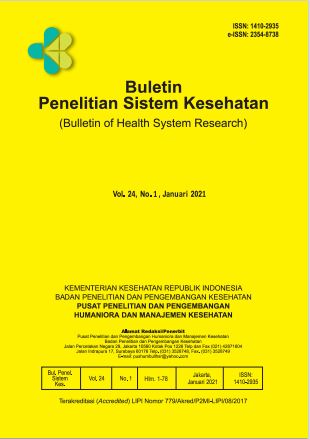Hubungan Paritas dan Karakteristik Individu terhadap Pemakaian Alat Kontrasepsi diantara Wanita Usia Subur di Provinsi Jawa Timur Tahun 2017
Abstract
East Java Province, which is dominated by Javanese and Madurese, has a community with cultural characteristics that consider having a large number of children will many fortunes. This study aimed to analyze the relationship of parity on the use of contraceptives in women of childbearing age in East Java. The study used data from the 2017 Indonesian Demographic and Health Survey. The population was women of reproductive age (15-49 years) in East Java. By using stratification and multistage random sampling obtained 5,593 respondents. In addition to the use of contraceptives and parity, other variables were the type of residence, age group, level of education, work status, marital status, socioeconomic status, and health insurance ownership. Determination of influence using binary logistic regression. The results showed that parity was one of the determinants of contraceptive use in East Java. Multiparous women of childbearing age were 4.114 times higher than primiparous women for contraception. Women in the 15-19 age group were 8.413 times more likely to use contraception than the 45-49 year age group. While women in the age group 40-44 years have the possibility of 2.209 times. Women with an elementary-junior high school education were 3.931 times more likely than those without school to use contraception. While those with tertiary education are likely 4.957 times compared to those not in school. Poor women were 1.525 times more likely than the poorest to use contraception. It could be concluded that parity was one of the determinants of contraceptive use in women of childbearing age in East Java Province.
Abstrak
Provinsi Jawa Timur didominasi oleh suku Jawa dan Madura. Kedua suku memiliki karakter pandangan budaya
tentang jumlah anak yang banyak, yaitu banyak anak, banyak rejeki. Penelitian ditujukan untuk menganalisis hubungan paritas terhadap pemakaian alat kontrasepsi pada wanita usia subur di Jawa Timur. Penelitian menggunakan data Survei Demografi dan Kesehatan Indonesia Tahun 2017. Populasi adalah wanita usia subur (15-49 tahun) di Jawa Timur. Dengan menggunakan stratification and multistage random sampling didapatkan 5.593 responden. Selain pemakaian alat kontrasepsi dan paritas, variabel lain yang adalah tipe tempat tinggal, kelompok umur, tingkat pendidikan, status bekerja, status perkawinan, status sosioekonomi, dan kepemilikan asuransi kesehatan. Penentuan pengaruh menggunakan regresi logistik biner. Hasil penelitian menunjukkan bahwa paritas merupakan salah satu determinan pemakaian alat kontrasepsi di Jawa Timur. Wanita multipara kemungkinan 4,114 kali lebih tinggi dibanding wanita primipara untuk memakai alat kontrasepsi. Wanita pada kelompok umur 15-19 tahun memiliki kemungkinan 8,413 kali dibanding kelompok umur 45-49 tahun untuk memakai alat kontrasepsi. Sementara wanita pada kelompok umur 40-44 tahun memiliki kemungkinan 2,209 kali. Wanita berpendidikan SD-SLTP kemungkinan 3,931 kali dibanding yang tidak sekolah untuk memakai alat kontrasepsi. Sedang yang berpendidikan perguruan tinggi kemungkinan 4,957 kalidibanding yang tidak sekolah. Wanita miskin kemungkinan 1,525 kali dibanding yang paling miskin untuk memakai alat kontrasepsi. Dapat disimpulkan bahwa paritas merupakan salah satu determinan pemakaian alat kontrasepsi pada wanita usia subur di Provinsi Jawa Timur.
References
Agustina, Z. A. and Izza, N. (2019) ‘Sistem Pembayaran Kolektif Peserta Mandiri dengan Status Kepesertaan dan Kepatuhan Pembayaran Iuran BPJS Kesehatan di Kabupaten Malang’, Buletin Penelitian Sistem Kesehatan, 22(1), pp. 44–53. https://doi.org/10.22435/hsr.v22i1.157.
Agyire-Tettey, F. et al. (2019) ‘Trends and determinants of socioeconomic inequalities in sexual and reproductive health among women in Ghana’, International Journal of Development Issues, 18(2), pp. 209–228. https://doi.org/10.1108/IJDI-12-2018-0198.
Al-Shaikh, G. et al. (2017) ‘Grand multiparity and the possible risk of adverse maternal and neonatal outcomes: a dilemma to be deciphered’, BMC Pregnancy Childbirth, 17(1), p. 310. https://doi.org/10.1186/s12884-017-1508-0.
Ali, M. et al. (2019) ‘Are family planning vouchers effective in increasing use, improving equity and reaching the underserved? An evaluation of a voucher program in Pakistan’, BMC Health Services Research, 19(1), p. Article number 200. https://doi.org/10.1186/s12913-019-4027-z.
Ali, M., Azmat, S. K. and Hamza, H. B. (2018) ‘Assessment of modern contraceptives continuation, switching and discontinuation among clients in Pakistan: Study protocol of 24-months post family planning voucher intervention follow up’, BMC Health Services Research, 18(1), p. Article number 359. https://doi.org/10.1186/s12913-018-3156-0.
Appiah, F. et al. (2020) ‘Trends and determinants of contraceptive use among female adolescents in Ghana: Analysis of 2003–2014 demographic and Health Surveys’, SSM - Population Health. Elsevier Ltd, 10, p. 100554. https://doi.org/10.1016/j.ssmph.2020.100554.
Badan Pusat Statistik (2018) Proyeksi Penduduk Indonesia 2015-2045. Jakarta.
Beenackersa, M. A. et al. (2018) ‘Urban population density and mortality in a compact Dutch city: 23-year follow-up of the Dutch GLOBE study’, Health & Place, 53, pp. 79–85. https://doi.org/10.1016/j.healthplace.2018.06.010.
Bhandari, R. et al. (2019) ‘Long acting reversible contraception use and associated factors among married women of reproductive age in Nepal’, PLoS ONE, 14(3), p. Article number e0214590. https://doi.org/10.1371/journal.pone.0214590.
Efendi, F. et al. (2020) ‘Determinants of contraceptive use among married women in Indonesia’, F1000Research, 9, p. Article number 193. doi: 10.12688/f1000research.22482.1.
Flores Arias, M. L. et al. (2017) ‘Barriers to use of family planning methods among heterosexual Mexican couples’, Research and Theory for Nursing Practice, 31(2), pp. 107–120. https://doi.org/10.1891/1541-6577.31.2.107.
Gawron, L. M. et al. (2020) ‘The effect of a no-cost contraceptive initiative on method selection by women with housing insecurity’, Contraception, 101(3), pp. 205–209. https://doi.org/10.1016/j.contraception.2019.11.003.
Gonie, A. et al. (2018) ‘Determinants of family planning use among married women in bale eco-region, Southeast Ethiopia: A community based study’, BMC Women’s Health, 18(1), p. Article number 50. https://doi.org/10.1186/s12905-018-0539-7.
Harrington, E. K. et al. (2019) ‘Engaging men in an mHealth approach to support postpartum family planning among couples in Kenya: A qualitative study’, Reproductive Health, 16(1), p. Article number 17. https://doi.org/10.1186/s12978-019-0669-x.
Herowati, D. and Sugiharto, M. (2019) ‘Hubungan Antara Kemampuan Reproduksi, Kepemilikan Anak, Tempat Tinggal, Pendidikan Dan Status Bekerja Pada Wanita Sudah Menikah Dengan Pemakaian Kontrasepsi Hormonal Di Indonesia Tahun 2017’, Buletin Penelitian Sistem Kesehatan, 22(2), pp. 91–98. https://doi.org/10.22435/hsr.v22i2.1553.
Hiremath, R. N. et al. (2018) ‘Contraceptive use and its determinants amongst armed forces personnel’, Medical Journal Armed Forces India, 74(2), pp. 103–107. https://doi.org/10.1016/j.mjafi.2016.12.007.
Ipa, M. et al. (2020) ‘Variation of preventive practices and its association with malaria infection in eastern Indonesia: Findings from community-based survey’, PLoS ONE, 15(5), p. e0232909. https://doi.org/10.1371/journal.pone.0232909.
Junita, D. (2018) ‘Faktor-Faktor yang Berhubungan dengan Penggunaan Kontrasepsi AKDR (Alat Kontrasepsi Dalam Rahim) di BPS Rosmala Aini Palembang Tahun 2018’, SCIENTIA JOURNAL, 7(1), pp. 32–37.
Karaoglan, D. and Saraçoglu, D. S. (2020) ‘Women’s socioeconomic status and choice of birth control method: An investigation for the case of Turkey’, Journal of Biosocial Science, In press, p. In press. https://doi.org/10.1017/S0021932020000103.
Kasnodihardjo (2014) ‘Nilai Anak dalam Keluarga dan Upaya Pemeliharaan Kesehatannya (Value of Children in The Family and Health Care)’, Jurnal Ekologi Kesehatan, 13(4), pp. 354 – 362.
Kiemtoré, S. et al. (2019) ‘Factors limiting the use of modern contraceptive methods in mothers with children aged 12-23 months at the yalgado ouedraogo university hospital in Ouagadougou, Burkina Faso’, Medecine et Sante Tropicales, 29(2), pp. 200–205. https://doi.org/10.1684/mst.2019.0899.
Kristiana, L. et al. (2012) Buku Seri Etnografi Kesehatan Ibu dan Anak 2012; Etnik Jawa, Desa Gading Sari, Kecamatan Sanden, Kabupaten Bantul, Provinsi DaerahIstimewa Yogyakarta. Jakarta: Badan Penelian dan Pengembangan Kesehatan, Kementerian Kesehatan Republik Indonesia. Available at: https://www.scribd.com/doc/142690361/Buku-Seri-Etnografi-Kesehatan-Ibu-dan-Anak-2012-Etnik-Jawa-Desa-Gading-Sari-Kecamatan-Sanden-Kabupaten-Bantul-Provinsi-DaerahIstimewa-Yogyakarta.
Laksono, A. D., Paramita, A. and Wulandari, R. D. (2020) ‘Socioeconomic Disparities of Facility-Based Childbirth in Indonesia’, International Medical Journal, 25(1), pp. 291–298.
Laksono, A. D. and Wulandari, R. D. (2020) ‘The Barrier to Maternity Care in Rural Indonesia’, J Public Health (Berl.): From Theory to Practice, p. Online First. https://doi.org/10.1007/s10389-020-01274-3.
Laksono, A. D., Wulandari, R. D. and Matahari, R. (2020) ‘The association between recent sexual activity and the use of modern contraceptive methods among married/cohabiting women in Indonesia’, Journal of Public Health Research, 9(4), p. 1885. https://doi.org/10.4081/jphr.2020.1885.
Megatsari, H. et al. (2020) ‘The community psychosocial burden during the COVID-19 pandemic in Indonesia’, Heliyon, 6(10), p. Article number e05136. https://doi.org/10.1016/j.heliyon.2020.e05136.
Mosher, W. D., Moreau, C. and Lantos, H. (2016) ‘Trends and determinants of IUD use in the USA, 2002-2012’, Human Reproduction, 31(8), pp. 1696–1702. https://doi.org/10.1093/humrep/dew117.
Mushy, S. E. et al. (2020) ‘Barriers to the uptake of modern family planning methods among female youth of Temeke District in Dar es Salaam, Tanzania: A qualitative study’, Sexual and Reproductive Healthcare, 24, p. Article number 100499. https://doi.org/10.1016/j.srhc.2020.100499.
Nsanya, M. K. et al. (2019) ‘Modern contraceptive use among sexually active women aged 15-19 years in North-Western Tanzania: Results from the Adolescent 360 (A360) baseline survey’, BMJ Open, 9(8), p. Article number e030485. https://doi.org/10.1136/bmjopen-2019-030485.
Ochako, R. et al. (2015) ‘Barriers to modern contraceptive methods uptake among young women in Kenya: A qualitative study Global Health’, BMC Public Health, 15(1), p. Article number 118. https://doi.org/10.1186/s12889-015-1483-1.
Ochako, R. et al. (2017) ‘Determinants of modern contraceptive use among sexually active men in Kenya’, Reproductive Health, 14(1), p. Article number 56. https://doi.org/10.1186/s12978-017-0316-3.
Population Reference Bureau (2020) Percent of Married Women 15-49 Using Contraception, All Methods. Available at: https://www.prb.org/international/indicator/fp-all/map/country/ (Accessed: 25 March 2020).
Rohmah, N. et al. (2020) ‘Determinants of teenage pregnancy in Indonesia’, Indian Journal of Forensic Medicine and Toxicology, 14(3), pp. 2080–2085.
Solanke, B. L. et al. (2018) ‘Maternal grand multiparity and intention to use modern contraceptives in Nigeria’, BMC Public Health, 18, p. Article number 1207. https://doi.org/10.1186/s12889-018-6130-1.
Srinivas, K. S. N. and Murali, R. (2019) ‘A hospital based cross sectional study: Distribution of study ladies according to usage of family planning methods and previous history of hypertension’, International Journal of Pharmaceutical Research, 11, pp. 75–80.
De Vargas Nunes Coll, C. et al. (2019) ‘Contraception in adolescence: The influence of parity and marital status on contraceptive use in 73 low-and middle-income countries’, Reproductive Health, 16(1), p. Article number 21. https://doi.org/10.1186/s12978-019-0686-9.
Widyasari, R. et al. (2012) The 2012 Maternal and Child Health Ethnographic Series, Madura Ethnic Jrangoan Village, Omben District Sampang Regency, East Java Province (Buku Seri Etnografi Kesehatan Ibu dan Anak 2012, Etnik Madura Desa Jrangoan, Kecamatan Omben Kabupaten Sampang, Pro. Jakarta: Badan Penelitian dan Pengembangan Kesehatan, Kementerian Kesehatan RI. Available at: https://www.scribd.com/doc/142716339/Buku-Seri-Etnografi-Kesehatan-Ibu-dan-Anak-2012-Etnik-Madura-Desa-Jrangoan-Kecamatan-Omben-Kabupaten-Sampang-Provinsi-Jawa-Timur.
World Health Organization (2020) What are the health risks related to overcrowding? Available at: https://www.who.int/water_sanitation_health/emergencies/qa/emergencies_qa9/en/ (Accessed: 25 March 2020).
Wulandari, R. D. et al. (2019) ‘Socioeconomic Disparities in Hospital Utilization among Elderly People in Indonesia’, Indian Journal of Public Health Research and Development. Surabaya, 10(11), pp. 1800–1804. https://doi.org/10.5958/0976-5506.2019.03885.3.
Wulandari, R. D. and Laksono, A. D. (2020a) ‘Determinants of knowledge of pregnancy danger signs in Indonesia’, PLoS ONE, 15(5), p. Article number e0232550. https://doi.org/10.1371/journal.pone.0232550.
Wulandari, R. D. and Laksono, A. D. (2020b) ‘Education as predictor of the knowledge of pregnancy danger signs in Rural Indonesia’, International Journal of Innovation, Creativity and Change, 13(1), pp. 1037–1051.
Wulandari, R. D. and Laksono, A. D. (2020c) ‘The association of socioeconomic status on early marriage among women in Rural Indonesia (Hubungan status ekonomi terhadap pernikahan dini pada perempuan di perdesaan indonesia)’, Jurnal Kesehatan Reproduksi, 11(2), pp. 115–124. https://doi.org/10.22435/kespro.v11i2.3870.115-124.
Wulandari, R. D., Laksono, A. D. and Nantabah, Z. K. (2020) ‘Effect of Marital Status on Completeness of Antenatal Care Visits among Childbearing Age Women in Rural Indonesia’, Medico-legal Update, 20(4), pp. 2253–2258.
Wulandari, R. D., Putri, N. K. and Laksono, A. D. (2020) ‘Socioeconomic Disparities in Antenatal Care Utilisation in Urban Indonesia’, International Journal of Innovation, Creativity and Change, 14(2), pp. 498–514.
Yadav, K. et al. (2017) ‘Determinants of non-use of family planning methods by young married women (15-24 years) living in urban slums of Uttar Pradesh’, Indian Journal of Community Health, 29(1), pp. 55–66.
Zurizah, Y. (2015) ‘Faktor-Faktor yang Berhubungan dengan Pemakaian Alat Kontrasepsi Intra Uterine Device (IUD) di Klinik Budi Mulia Medika Palembang Tahun 2013’, Jurnal Medical Science Ilmu Kesehatan Akademi Kebidanan Budi Mulia Palembang, 5(1), pp. 43–55. https://doi.org/10.35325/kebidanan.v5i1.77.


















